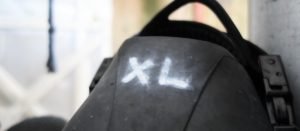When it comes to marking your gear, there are a few options:
- Writing on it with a permanent marker/texter
- Writing on it with special fabric paint
- Engraving
- Putting a sticker on it
- Attaching a tag to it
The best marker
Sharpies
Industrial Sharpie
Sharpie make an Industrial Strength and Extreme Fade Resistant Sharpies. They are as good as you think it is, and comes in normal (“fine”) and small (“extra fine”). Black only.

Metallic Sharpie
For writing on dark things, you need this – the silver metallic Sharpie. Almost as tough as the industrial black. Silver only.
Paint pens
 This is what a lot of the industrial world uses, and with good reason. And yes – Sharpie makes these as well, but there are plenty of other good brands out there. White is the most recommended colour to use, for visibility.
This is what a lot of the industrial world uses, and with good reason. And yes – Sharpie makes these as well, but there are plenty of other good brands out there. White is the most recommended colour to use, for visibility.
Fabric paint

There is no perfect paint. In fact, many people have gone back to Sharpies. However, if you put the paint in the right places, and resign yourself to reapplication every now and then, using fabric paint is a great way to make your neoprene items stand out.
I have a bog-standard Aqualung 3mm wet suit that looks just like every other rental wetsuit, so I put my initials inside, just below the collar, to identify it. Sides of my boots as well.
There are a couple options when it comes to suitable fabric paints.
Scribbles 3D Fabric Paint
Scuba Goop is pretty decent stuff on fabric, but do not be tempted to put it on nylon (like BCDs or SMB bags).
If you peel off a Scuba Goop label, you’ll find this label underneath. Same product, cheaper price.
Trident U-Mark It
A similar, competing product.
ST Art Material 3D Fabric Paint
A Thai product that was fairly cheap (about $1.80 USD), found in larger art supply shops. http://www.startmaterial.com

Stickers
These are often the most visually attractive, but least permanent option. While there are stickers made for scuba gear, due to the rough nature of the elements and metal, they have a tendency to wear away quickly if they are not places appropriately.

I have used Diving Labels which are very popular throughout the Philippines, where they are based.
Where they are not good to place:
- On anything flexible
- On tanks (too much heavy abrasion)
- On anything porous or not smooth
- Anything gripped regularly (handles and similar)

So, where are they good to apply?
- Camera housings
- Finger spools
- Gear hangers
- Torches
- Some dive computers (like the Suunto Zoop)
Engraving
Engraving is about as permanent as it gets, but is often one of the ugliest methods. Good for a busy dive shop, though, where durability is important.
The most common way to engrave is with a tool like a Dremel. There are plenty of other brands and knock-offs to choose from, but for the workload a diveshop would use, I can only recommend the original. Cordless vs corded is an issue, because of voltage issues. Bosch AL1130CV European charger is more flexible with input voltages, and compatible with the Dremel batteries (Dremel is owned by Bosch).
A little bit of enamel paint in the marking can really help it to stand out.
Tags

Avoid plastic tags as the breakage rate is always too high.
Metal tags which have been stamped are the clearest. Metal tags which have been hand engraved are the middle ground. I recommend stamping over engraving.
In either case, just like with hand engraving, using a little enamel paint in the impressions is easily applied and creates a strong visual contrast.
Lasers
As shark owners know, everything is better with lasers.
While laser engraving can be relatively expensive, it is clear, visible and highly customisable. It is perfect for metal scuba tanks and any other large, metallic surfaces.
Metal tags with laser engraving combines the best of both worlds – low prices (relatively speaking) with clear markings. A dive shop or private owner can include a lot more information on an engraved tag than with a stamped one. DAN membership number, email address, shop logo and so on are all options.
